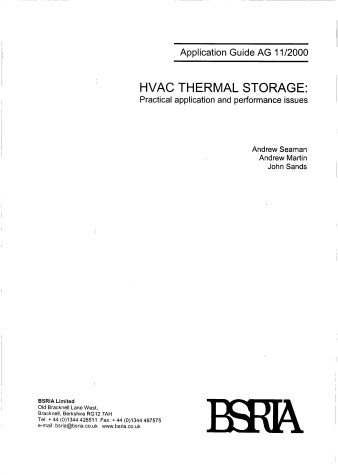Technical Note
5 total works
TN 9/94
This report provides guidance on the use of building fabric as a storage medium for heating and cooling energy transported by circulating air. Particular attention is paid to the use of concrete slabs for storage of free cooling available from low ambient overnight air temperature. This work includes an introduction to the concept of fabric energy storage and a discussion of design considerations. Information is provided on the general performance of the systems in terms of maintaining comfortable temperatures in the occupied space, incorporating the expected variation with key parameters including - thermal mass, thermal linking between the fabric and the circulating air, ventilation rate and climate. The information provided is based on case studies and simulation modeling. Capital and energy consumption/cost data is also provided.
v. 3/95
v. 4/95
Building and energy management systems (BEMS) are increasingly used to provide enhanced control and monitoring of the building environment and services, with the aim of reducing energy consumption and improving comfort. This book looks at BEMS as condition-based monitoring tools.
v. 1/95
This report gives an overview of the application of condition monitoring to the maintenance of building services. It is the first of four based on the results of a research project. The other publications in the series which consider in detail specific techniques identified as having the most widespread potential are: "Infrared Condition Based Maintenance (IR CBM) of Electrical Panels and Associated Equipment" TR 2/95; "Vibration Monitoring in Building Services" TR 3/95; "Building Energy Management Systems as Condition Based Maintenance Tools" TR 4/95. Modern buildings support valuable business activities with a range of complex mechanical and electrical services. Heating, ventilation and air conditioning (HVAC) systems are necessary to provide an environment in which people and equipment can function effectively. Power supplies are essential to the operation of computers and communications. Building services are therefore critical to the business activity. Condition-based monitoring (CBM) is performed by selecting and monitoring a parameter which is indicative of plant condition. Any necessary remedial maintenance is then determined from diagnosis of the information collected.
CBM has the potential both to reduce the costs and increase the effectiveness of maintenance in a number of building services applications. This "Technical Note" gives an appraisal of the potential offered by CBM to building services, focusing on non-specialist plant (plant which is not normally maintained by specialist contractors).
CBM has the potential both to reduce the costs and increase the effectiveness of maintenance in a number of building services applications. This "Technical Note" gives an appraisal of the potential offered by CBM to building services, focusing on non-specialist plant (plant which is not normally maintained by specialist contractors).
v. 2/95
Infrared Condition Based Maintenance of Electrical Panels and Associated Equipment
by N Barnard
Published April 1995
Part of the Building Services Research and Information Association's (BSRIA) Technical Notes series, this title covers infrared condition-based maintenance of electrical panels and associated equipment.

